Don’t Fear The Rambutan
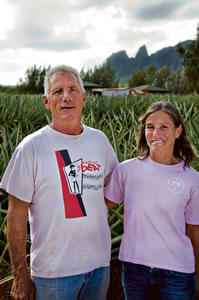
Paul and Jude Huber. Daniel Lane photos
Paul and Jude Huber have been growing extra-fancy dessert pineapple and rambutan tan on 38 acres in Moloa’a since 1995. They have created a five-acre microclimate similar to the native conditions in which rambutan flourishes. The Hubers are known for producing big, juicy rambutan.
What’s growing: Rambutan, sugarloaf pineapple
RAMBUTAN
When people first see a bright red rambutan with its long, pliable spine-like hairs, they recoil. Don’t be afraid to try it because inside, the pearlescent jewel of a fruit is sweet, slightly acidic and juicy. The flesh is similar to a grape, and surrounds a single seed.
In Malaysia, the word rambutan means “hairy” and the Vietnamese call the fruit chom chom, meaning “messy hair.”
Season: Taking about six months to go from flower to edible fruit, the rambutan begins to ripen in October, peaks at Christmas and runs through March. “This year, we have a lot of fruit but it’s really late, because we had a wet, early summer,” says Jude, whose rambutan started to ripen in mid-November.
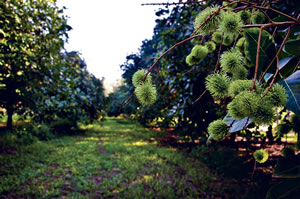
Hole in the Mountain Farm’s microclimate is similar to rambutan’s native Malaysia
What to look for: Fruit that is still on the branch indicates freshness, and will store longer. If not on the branch, select fruit without cracks or mold. Fruit should have a fresh smell. A good quality rambutan will have flesh that easily separates from the seed.
Storage: Fruit can be stored at room temperature for six days or refrigerated for up to 12. Stored at room temperature, rambutan loses about 25 percent of its weight, mostly through dehydration of the peel and hair. The drying turns the fruit dark, which gives it an awful appearance. These fruits are totally edible, because there is little deterioration in fruit quality. Storing in the refrigerator in sealed plastic bags can reduce the darkening process.
Tip: Remove the top half of the peel and use the bottom half to hold the succulent fruit while you take juicy nibbles. That way, the sweet nectar will only run down your throat, not your hand.
Preparation: The soft shell is easy to peel with a small knife, or a quick twist. Once open, the fruit will pop out. They can be muddled into cocktails, tossed with tropical fruit salads, or simmered with aromatics to make a flavorful simple syrup. Rambutan also is canned in syrup, and used in jams, jellies and sorbet. The colorful fruit is frequently used in floral arrangements.
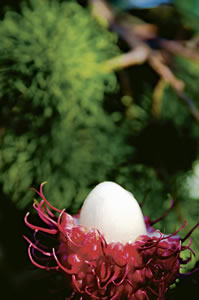
A big, juicy rambutan
Health benefits: High in niacin (B2) and vitamin C, one cup of rambutan has 37 percent of the USDA recommendation for manganese. Manganese is one of several minerals required to prevent osteoporosis, and is used in the treatment of rheumatoid arthritis. Diabetics low in manganese may enjoy improved glucose metabolism when the deficiency is corrected.
Hole in the Mountain Farm’s produce can be found at: There is a big push to get local fruit in the school system, and you may see the Hubers’ rambutan on your child’s lunch plate soon. Farmers Market: Kapa’a (Wednesdays at 3 p.m.), Kaua’i Community College (Saturdays at 9:30 a.m.). Restaurant: Moloa’a Fruit Stand, and local distributor Esaki’s Produce. This year, the Hubers have a bountiful crop and will be selling 20-pound boxes along with smaller market amounts. For more information, call 639-2768.
RAMBUTINI
Rock the holiday season with a rambutan martini. You also can cheer things up by arranging the bright red fruit in clusters around the holiday table, place fruit with branches into vases, and muddle the flesh for this pre-dinner cocktail.
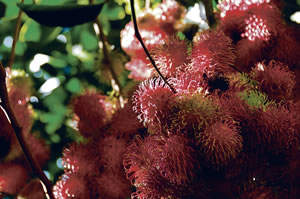
In Malaysia, the world rambutan means ‘hairy’
* 1 cup rambutan, peeled, seeded and roughly chopped
* 1/2 inch piece of fresh ginger, roughly chopped
* 3 ounces vodka
* 1 ounce Cointreau
* 2 ounces club soda
* ice
Place ginger in a martini shaker and lightly muddle; add rambutan and thoroughly muddle. Add the rest of the ingredients and give it a good 20-second shake until the outside of the shaker gets cold.
Strain into two martini glasses and enjoy.
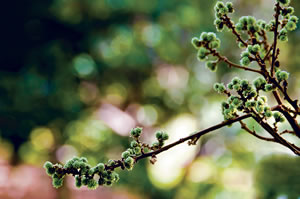
Rambutan takes six months to grow from flower to fruit



